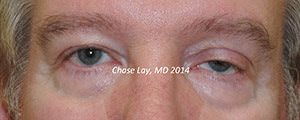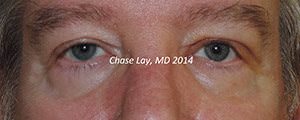Ptosis
Surgical correction of ptosis, whether it be acquired later in life or congenital, is one of the more challenging surgical treatments in the field of Facial Plastics and Oculoplastics. Cosmetic surgery of the eyelids whether it be Asian eyelid surgery or non-Asian eyelid surgery is less complex with a lower revision rate. In general surgical correction of ptosis is done by either shortening or repairing a tendon called the levator aponeurosis which is the tendon attached to the levator muscle of the upper eyelid. It is this muscle that is in control of the voluntary movement of your upper eyelid when looking straight ahead or looking up. In some cases, people are born with an absence of this muscle or the tendon or sometimes both.
Fortunately, this congenital form is less common when compared to acquired ptosis which is most often related to weakening or thinning of the levator tendon. This results in a droopy eyelid that often becomes worse as the day goes on. It is important that a medical evaluation be performed for ptosis before surgery because there are medical causes of ptosis that have to be ruled out before surgical treatment can be recommended. There is another type of ptosis related to a weakness of an involuntary muscle called the Mueller’s muscle. This is near the inner layer of the upper eyelid and this muscle can also be operated on or shortened to improve ptosis. Ptosis surgery can be performed with an internal approach or external approach depending on the condition, anatomy, and underlying cause of the ptosis.
The external approach involves an external incision similar to the one used for blepharoplasty of the upper eyelids. The tendon is exposed and shortened or repaired to improve the position of the eyelid. The internal approach, sometimes known as a “Putterman” procedure, involves shortening the inner 2 layers of the eyelid, the conjunctiva, and the Mueller’s muscle.


Successful ptosis surgery requires experience and detailed knowledge of eyelid anatomy both in its normal state and abnormal state. Ptosis surgery in the Asian eyelid is especially challenging and requires very specific expertise. Dr. Lay prides himself on his success rate with the surgeries and enjoys the challenge it creates in particular with the Asian eyelid.
Ptosis surgery has a higher revision rate than cosmetic eyelid surgery and patients should be aware of this before undergoing ptosis repair for mild to moderate ptosis that is not obstructing their vision. While it is possible to undergo surgery for very mild to moderate cosmetic ptosis you should always keep in mind that there is a chance that the symmetry you’re looking for as the patient cannot be guaranteed. While Dr. Lay performs surgery for mild to moderate ptosis he does feel patients benefit more from when the ptosis is more significant or obstructing vision.
